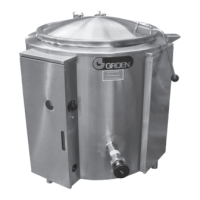12 OM/SM-EE-CE
g. As part of the daily cleaning program, clean
soiled external and internal surfaces.
Remember to check the sides of the unit
and control housing.
h. To remove stuck materials, use a brush,
sponge, cloth, plastic or rubber scraper, or
plastic wool with the cleaning solution. To
reduce effort required in washing, let the
detergent solution sit in the kettle and soak
into the residue. Do NOT use abrasive
materials or metal tools that might scratch
the surface. Scratches make the surface
harder to clean and provide places for
bacteria to grow.
Do NOT use steel wool, which may leave
particles in the surface and cause eventual
corrosion and pitting.
i. The outside of the unit may be polished with
a stainless steel cleaner such as “Zepper”
from Zep Manufacturing Co. or Groen
DeGreaser (Part No. 140830).
J. When equipment needs to be sanitized, use
a solution equivalent to one that supplies
200 parts per million available chlorine.
Obtain advice on sanitizing agents from
your supplier of sanitizing products.
Following the supplier’s instructions,
apply the agent after the unit has been
cleaned and drained. Rinse off the
sanitizer thoroughly.
k. It is recommended that each piece of
equipment be sanitized just before use.
l. If there is difficulty removing mineral
deposits or a film left by hard water or
food residues, clean the kettle thoroughly
and then use a deliming agent, like Groen
Delimer/Descaler (Part Number 114800) or
Lime-A-Way
®
from Ecolab, in accordance
with the manufacturer’s directions. Rinse
and drain the unit before further use.
m. If cleaning problems persist, contact your
cleaning product representative for
assistance.
8.4 Ball Valve
Some kettles are equipped with an optional
ball valve. This valve can be easily
disassembled for cleaning. These parts may
be cleaned in a standard sanitizer or in
a dish washing machine.
CAUTION
NEVER LEAVE A CHLORINE SANITIZER
IN CONTACT WITH STAINLESS STEEL
SURFACES LONGER THAN 30 MINUTES.
LONGER CONTACT CAN CAUSE STAINING
AND CORROSION.

